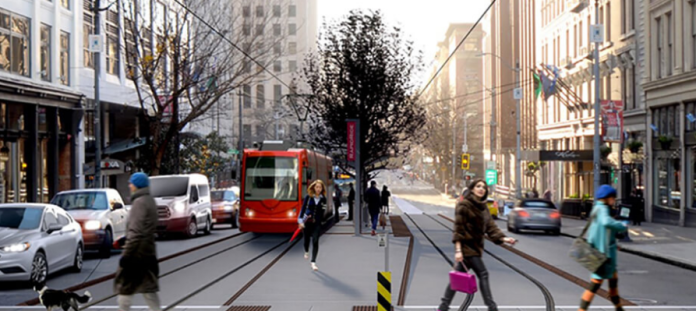Mayor Jenny Durkan’s outside budget review of the Center City Connector streetcar project is ten days past due.
The consultant KMPG delivered a draft of the report on June 7th, ahead of the June 19th deadline, David Gutman reported in The Seattle Times. Mayor Durkan, however, asked for more information, specifically about other options to serve the transit corridor. “Stephanie Formas, a Durkan spokeswoman, said that KPMG verbally briefed the mayor last week and that she asked for more analysis and ‘more detailed information for additional alternatives for providing transit connections moving forward,’” Gutman wrote.
The mayor’s statement worried some transit advocates.
“Our mayor at best does not take transit seriously, at worst is openly hostile to it. These delays risk a $75 million federal grant. It’s irresponsible,” Robert Cruickshank tweeted.
Part of the agony over the streetcar decision stems from the limitations of the other First Avenue transit options. And just what are these other options Mayor Durkan is mulling?
The obvious choice is bus service. However, many obstacles stand in the way of converting the connector to a bus project. For starters, the bus option would lose $75 million in federal grants. With federal transportation grants mainly going to Red states under the current administration, now is not a good time to be a Blue state at the back of the line for grants. Connecting two disconnected streetcar stub-lines has real value that a bus line cannot easily replicate. Only by decommissioning the other two streetcar lines could one create a single efficient rapid bus line. Short of that, the city would only create a messy patchwork where bus service sutures together the South Lake Union and First Hill streetcar lines but does not correct a situation where streetcar ridership continues to lag. It would also continue the pattern of short-changing First Hill.
And if the bus alternative is supposed be on par with the quality planned for the center city streetcar, it will likely cost nearly as much as a streetcar, though with less covered by federal grants. Center-running transit-only lanes require redesigning the street and purchasing new buses with doors on both sides. For comparison, look to Madison Street’s RapidRide G Line project which is budgeted at $120 million for 2.5 miles. Recreating Seattle’s planned streetcar loop as a rapid bus line may end up costing more than $200 million if RapidRide G’s costs are indicative. The Center City Connector is a 1.2-mile extension to bring the streetcar network to five miles in length. At twice the length of the $120 million RapidRide G Line, a five-mile-long center city bus rapid transit line would not be cheap.
https://twitter.com/cruickshank/status/1011991650044862464
The Durkan administration could also just do a bare minimum mediocre bus line. However, the Center City Connector is expected to take the streetcar to 20,000 daily riders in its first year and 35,000 by 2040. Those projections are a testament to serious demand along the route, and another slow bus is not going to get the job done. Ridership demand on that scale can’t be solved away by some new innovation.
Another issue is the delay itself is racking up costs. The consultant firm pocketed $416,000 for the yet-to-be-released review. The Seattle Department of Transportation estimated the delay will add $10 million to $14 million to the budget, largely due to cost escalation in contracting. Utility work continues in the Pioneer Square section of First Avenue as the fate of the streetcar is decided.
In a brilliant bit of timing, Mayor Durkan’s pause and reassess move came right as the president initiated a global trade war that has jacked up the price of steel.
SDOT Estimates Cost of Delaying Streetcar Project at More Than $10 Million
Doug Trumm is publisher of The Urbanist. An Urbanist writer since 2015, he dreams of pedestrian streets, bus lanes, and a mass-timber building spree to end our housing crisis. He graduated from the Evans School of Public Policy and Governance at the University of Washington in 2019. He lives in Seattle's Fremont neighborhood and loves to explore the city by foot and by bike.


